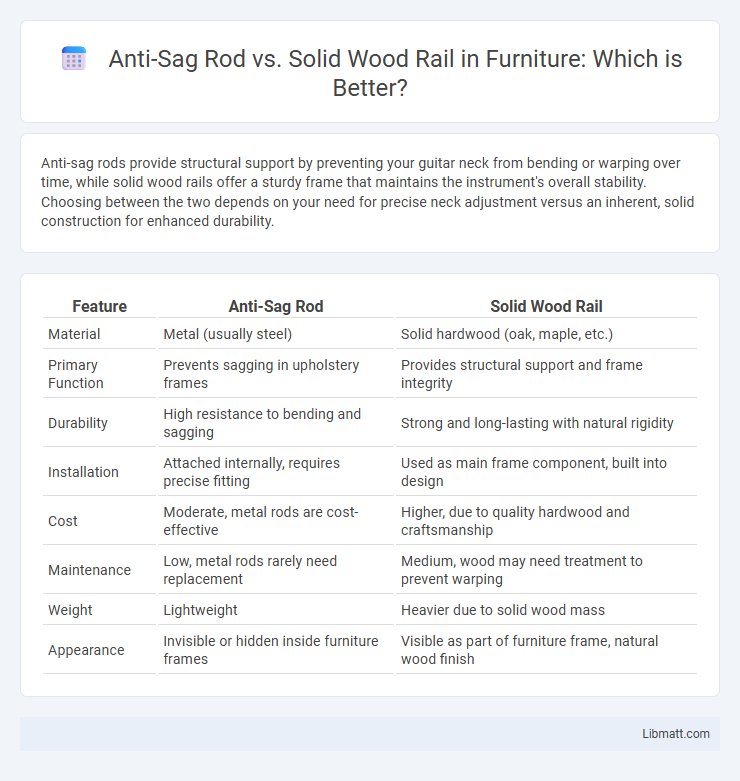Anti-sag rods provide structural support by preventing your guitar neck from bending or warping over time, while solid wood rails offer a sturdy frame that maintains the instrument's overall stability. Choosing between the two depends on your need for precise neck adjustment versus an inherent, solid construction for enhanced durability.
Table of Comparison
| Feature | Anti-Sag Rod | Solid Wood Rail |
|---|---|---|
| Material | Metal (usually steel) | Solid hardwood (oak, maple, etc.) |
| Primary Function | Prevents sagging in upholstery frames | Provides structural support and frame integrity |
| Durability | High resistance to bending and sagging | Strong and long-lasting with natural rigidity |
| Installation | Attached internally, requires precise fitting | Used as main frame component, built into design |
| Cost | Moderate, metal rods are cost-effective | Higher, due to quality hardwood and craftsmanship |
| Maintenance | Low, metal rods rarely need replacement | Medium, wood may need treatment to prevent warping |
| Weight | Lightweight | Heavier due to solid wood mass |
| Appearance | Invisible or hidden inside furniture frames | Visible as part of furniture frame, natural wood finish |
Introduction to Anti-Sag Rods and Solid Wood Rails
Anti-sag rods are metal supports designed to reinforce furniture frames and prevent sagging over time, enhancing durability and stability. Solid wood rails, constructed from dense, high-quality timber, provide inherent strength and structural integrity to furniture pieces, minimizing the risk of deformation. Both components serve essential roles in maintaining the longevity and performance of furniture, with anti-sag rods offering adjustable reinforcement and solid wood rails delivering natural rigidity.
Purpose and Function in Door and Gate Construction
Anti-sag rods reinforce doors and gates by preventing warping and sagging, maintaining structural integrity over time. Solid wood rails provide foundational support and rigidity, ensuring the door or gate holds its shape and functions smoothly. The anti-sag rod complements the solid wood rail by adding tensile strength, especially in large or heavy wooden assemblies.
Material Composition and Design Differences
Anti-sag rods are typically made from metal alloys such as steel or aluminum, designed to provide adjustable tension that prevents bed rails from bowing under weight. Solid wood rails are crafted from hardwoods like oak, maple, or walnut, offering structural support through their dense, natural composition without mechanical adjustment. The key design difference lies in the anti-sag rod's ability to counteract sagging dynamically, whereas solid wood rails rely on inherent material strength and thickness for durability.
Installation Process: Anti-Sag Rods vs Solid Wood Rails
Anti-sag rods require minimal installation effort, typically involving simple adjustments and secure attachment to bed frames to prevent mattress bowing. Solid wood rails demand precise measurement, cutting, and fastening, making the process more labor-intensive and time-consuming. Choosing anti-sag rods offers a quicker, less complex solution compared to the traditional, installation-heavy approach of solid wood rails.
Strength and Durability Comparison
An anti-sag rod enhances bed frame stability by preventing wooden rails from bowing under weight, offering additional support compared to solid wood rails alone. Solid wood rails provide natural strength but may weaken or warp over time without reinforcement, especially under heavy loads. Your bed's longevity and strength can be significantly improved by combining solid wood rails with anti-sag rods for optimal durability.
Weight and Structural Support Analysis
An anti-sag rod significantly reduces mattress sagging by providing targeted central support without adding substantial weight to the bed frame. Solid wood rails offer robust structural integrity due to their dense, heavy material, which inherently supports the mattress but increases the overall bed weight. Weight distribution efficiency favors anti-sag rods for lightweight frames, while solid wood rails excel in durability and long-term structural reinforcement in heavier bed constructions.
Cost Efficiency and Budget Considerations
Anti-sag rods offer a cost-efficient solution for reinforcing bed frames without the expense of replacing existing rails, making them ideal for budget-conscious buyers. Solid wood rails, while typically more expensive upfront, provide long-term durability and stability that may reduce maintenance costs over time. You can optimize your budget by selecting anti-sag rods when seeking an affordable reinforcement method or investing in solid wood rails for a more permanent, sturdy frame upgrade.
Maintenance Requirements and Longevity
Anti-sag rods require minimal maintenance, primarily periodic tightening to maintain bed frame stability and prevent mattress sagging. Solid wood rails, while sturdy, may need occasional refinishing or tightening of joints to preserve structural integrity and appearance over time. Both options offer long-term durability, but anti-sag rods provide a more maintenance-free solution compared to the upkeep demands of solid wood rails.
Best Use Cases for Anti-Sag Rods and Solid Wood Rails
Anti-sag rods are ideal for supporting long or heavy shelves, preventing bowing by adding discreet reinforcement without altering the shelf's appearance. Solid wood rails work best for structural support in cabinetry or shelving units that require a sturdy framework, ensuring durability and strength over time. You can choose anti-sag rods for a minimalist look with effective shelf stabilization, while solid wood rails suit applications demanding robust, visible reinforcement.
Conclusion: Choosing the Right Support Solution
Choosing the right support solution depends on the specific needs of your furniture structure, with anti-sag rods providing adjustable, low-profile reinforcement to prevent frame bowing effectively. Solid wood rails offer robust, rigid support that enhances overall durability and contributes to a traditional aesthetic. Evaluate weight capacity, installation preferences, and long-term stability to determine whether the flexibility of anti-sag rods or the strength of solid wood rails best suits your project.
anti-sag rod vs solid wood rail Infographic

 libmatt.com
libmatt.com